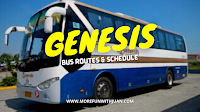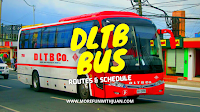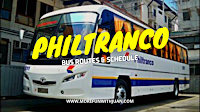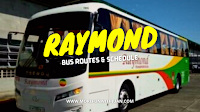With a rudimentary rail network, the Philippines' intercity bus network is extensive, and most cities and towns can be reached by bus. Even with competition from airlines, buses transport people across the country efficiently, if not on schedule.
Loading...
Transport Regulation
The industry is regulated by the Land Transportation Franchising and Regulatory Board (LTFRB), a government agency which also regulates most forms of public land transportation, including jeepneys but not tricycles.
Fares must follow a tariff, and companies are subject to strict safety standards. They also have a hotline to report violations by drivers and operators, from overcharging to serious safety violations.
There are two major categories of buses, provincial buses, which zip through the provinces to connect every major city or town, and city buses, which are less common as most places would have jeepneys instead as streets are narrow.
You can also find tourist buses approved by the Philippines' tourism department, and range from shuttles offered by some hotels, to ones chartered for group tours.
TRAVEL ESSENTIALS
Here are some things you might consider bringing with you for your day tour / adventure:
- Stylish face mask
- Water container/tumbler to rehydrate
- Sunscreen for skin protection
- Goggles for swimming or snorkeling
- Stylish Swimsuit
- Travel backpack / luggage
- Reusable vacuum storage packs
- Selfie stick
- Waterproof phone case
- Acion cam
- Camping tent
- WiFi kit
- Power bank
Shopee is my go-to app for things I needed like the ones above. If you'd like discounts and vouchers, you may get the best offers here:
Provincial Buses in the Philippines
Provincial buses form the backbone of inter-city and regional transportation, and while jeepneys may take their place in some routes where a full-size bus is too large for some roads along the route or there is not any significant demand, most places within the tourist trail should be reached by at least one or more provincial bus routes.
There are five classes for provincial buses, which are based on comfort, number of seats, and fare. The class of the bus should be indicated on the windshield, but some don't have them posted at all. From worst to best:
- Ordinary (regular/third class) — 2-3 layout (6 in the rearmost row), with 38-41 hard seats. Stops most frequently. Vehicle can range from a large jeepney or minibus to a full-size coach. Some buses may have two doors or the front hosting the conductor's seat. The vehicles are crowded and sometimes unsafe, and foreign travelers are advised not to take them. Windows are kept open, so passengers are exposed to the elements and increase risk of catching disease, and spitting is common on these buses.
- Air-conditioned (second class, also shortened to AC or A/C) — 2-3 layout (6 in the rearmost row) with hard seats. No other frills except the A/C. May stop frequently like ordinary buses, but stops are further apart (and can be on bus stations than on curbsides or pullouts)
- Deluxe (first class, also called executive by some companies) — 2-2 layout (5-6 in the rearmost row) with 36-38 hards seats. Skips more stops, and have better legroom than regular AC.
- Super deluxe - 2-2 layout (6 in the rearmost row) with 34 reclining seats. Stops only at major cities and towns. May have restrooms, personal entertainment screens, and blankets.
- Luxury - 2-1 layout with 26 fully reclining seats, which can be turned to beds on overnight trips. Stops only at major cities (or run non-stop, not including food and toilet breaks), but rarer.
As a rule of thumb, "commuter" or short/medium-distance buses are usually run with air-conditioned or ordinary buses, while long-distance services (with meal stops/toilet breaks) are run with higher-class buses.
In practice however, ordinary buses can be seen in long-haul routes as well, and luxury buses are usually offered by the large bus companies, even on short routes between cities.
Bicol Isarog
Bicol Isarog Transport System Inc. or fondly abbreviated as BITSI, was formally registered as a business in 2011. Even though it's younger than most of its competitors, it has made a name for itself by being one of the most innovative bus lines in the country.
BITSI's automated ticketing terminals and 6 different bus types are what makes them stand out from the rest. Their sleeper buses are completely comfortable for long haul trips from Manila to Bicol.
Cagsawa
Cagsawa Bus does not have much of an online presence but their service is legit and unparalleled. Customers have praised them for their hospitable crew, on time departures, and spacious leg room. You're guaranteed a pleasant trip to the Bicol region with Cagsawa Bus. Make sure to book online for a sure seat!
Coda Lines
Coda Lines Bus Corporation is most well-known for its bus routes connecting Manila to the mountainous Cordillera Region. Their signature purple coaches have daily departures from Manila to Sagada, Bontoc, and Banaue. With their comfortable trips, Coda Lines promises to be your home on the road.
DLTBCo.
Services run from Manila to destinations in CALABARZON, Bicol, Samar and Leyte. The Del Monte Land Transport Bus Company (DLTBCo.) is owned by Del Monte Motor Works, a coachmaker, and is a revival of the Batangas-Laguna-Tayabas-Bicol Bus Company (BLTB, whose name is also similar with the present company)
Five Star
A large bus conglomerate, and a sister company of Victory Liner. Brands include Five Star and Luzon Cisco Transport. Five Star serves the same set of destinations as Victory Liner, but with a mix of air-conditioned and regular buses.
Luzon Cisco runs from Manila to Angeles, Tarlac City, Cabanatuan, Guimba, Talugtug, Santa Cruz (Zambales), Alaminos City and San Fabian.
Genesis Transport
 |
A bus company with routes from Manila to Cabanatuan and Baler, and Cabanatuan to Baguio. Its affiliates are JoyBus, which operates luxury buses, and North Genesis, which travels Manila-Baguio.
G.V. Florida Transport
The first bus company in the Philippines to operate sleeper buses, complete with bunks, on overnight routes. G.V. Florida buses run daily from Manila to destinations in Ilocos Region and Cagayan Valley. Buses have a distinctive pink livery with flowers.
Partas
Partas is a major bus company that runs most Manila to Ilocos services. Also has routes to Mindoro (San Jose), Baguio, and Abra.
Penafrancia
Penafrancia Travel and Tours' name was inspired by the miraculous image of the Virgin Mary that's revered in Naga City. The Our Lady of Penafrancia statue is considered the principal Patroness and Queen of Bicol. As part of the Bicol Isarog group of bus companies, Penafrancia hopes to reign supreme as the best transport option to and from Manila, Turbina, Bicol, and Sorsogon.
Philtranco
The oldest bus company in the Philippines and in Asia, founded in 1914. It primarily serves destinations in Bicol, but they also have routes to Samar, Leyte, Mindanao, Iloilo City and Zambales. Affiliates include Amihan Bus Line, which also travel to Bicol destinations of Philtranco.
Raymond Transport
Raymond Transport is a bus operator that serves Manila and Southern Tagalog provinces such as Bicol, Camarines Norte, Camarines Sur, Sorsogon, and Masbate. Although reviews are mixed about Raymond buses, we find that they get the job done just fine. Their super deluxe buses are especially a treat because passengers can travel in comfortable seats without getting bored.
Victory Liner
The largest bus company in the Philippines, with routes from Manila to many destinations in northern Luzon (Baguio, Pangasinan, Cagayan Valley, Central Luzon). Victory Liner's roots date back as early as the 1940s, when World War II ended.
Having been in the transport business for more than 70 years, it's not a surprise that Victory Liner is one of the leading bus operators in the Philippines. Its iconic white, red, orange, and yellow colored fleet plies through North and Central Luzon's key provinces.
Yanson Group of Bus Companies (YGBC)
A large Bacolod-based firm that runs multiple bus companies, and dominates the bus network in Visayas and Mindanao. Brands include Bachelor Express (Butuan to most points in Caraga, Davao City and Cagayan de Oro), Ceres Liner (most routes in the Visayas except Bohol, Samar and Leyte), Ceres Transport (Manila to Batangas, Panay and Bacolod), Gold Star (Manila to Batangas City and Mindoro), Mindanao Star (Davao City to Cotabato City), Rural Transit (routes west of Cagayan de Oro), Southern Star (routes in Bohol) and Sugbo Tours (some routes in Cebu operated by companies bought by YGBC).
If the bus company you are looking for is not on the list, SEARCH MORE BUSES HERE!
OTHER ATTRACTIONS TO SEE IN MANILA
Klook.comHow To Book a Trip / Reserve a Ticket
Here's a step-by-step guide on how you can get a ticket or check available trips online:
- Go to this link and INPUT the origin and destination in the search box (eg. Manila - Baguio)
- Input the dates of your desired arrival.
- Choose if it is One-way or Return trip.
- Choose the number of seats you wish to book or reserve
- Then click Find Tickets to search for the available trips


























This only receipt I got is from GCash payment. No SMS notif from biyaheroes.com to confirm my booking for me to change anything if there’s incorrect details. It seems there is something wrong with their website when booking. I was not able to receive a refund since they are gaslighting me my booking was wrong in terms of the destination. Can’t trust them again. Anyway, responsive customer support is available via email.
ReplyDelete